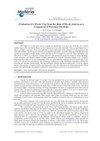Mössbauer光谱学和Rietveld精细化用于分析不锈钢的形状记忆效应(SME)
IF 1.2
4区 材料科学
Q4 MATERIALS SCIENCE, MULTIDISCIPLINARY
引用次数: 0
摘要
无后坐力射线的共振吸收,被称为穆斯堡尔光谱,是一种有效的核勘探技术,用于结构和磁性分析。在研究钢时,可以使用转换电子穆斯堡尔光谱技术(CEMS)准确地分析材料的表面,该技术可评估样品表面至200 nm的深度,而使用转换x射线穆斯堡尔光谱技术(CXMS)可以更深入地研究钢样品的内层(10m)。本研究采用该技术研究了不锈钢形状记忆的结晶学逆转(f.c.c.)。通过压缩试验机械诱导出六方马氏体相,热处理后观察到向奥氏体相的逆转。在室温和无外场条件下,利用铑基体中57Co源的电子转换和x射线进行了穆斯堡尔光谱测量。光谱分析采用专用的调整软件。结果表明:大逆转的本文章由计算机程序翻译,如有差异,请以英文原文为准。
Mössbauer spectroscopy and Rietveld refinement used to analyze stainless steel properties regarding shape memory effect (SME)
The resonant absorption of recoilless -rays, known as Mossbauer Spectroscopy, is an efficient nuclear prospecting technique to structural and magnetic analysis. When studying steels, it is possible to accurately analyze the surface of materials using the Conversion Electron Mossbauer Spectroscopy technique (CEMS) that evaluates the sample’s surface to a depth of 200 nm, and by Conversion X-ray Mossbauer Spectroscopy by (CXMS), which can go deeper and investigate inner layers of steel samples (10 m). In this work, this technique was employed to study the crystallographic reversion (f.c.c.h.c.p.) of stainless steel shape memory. A hexagonal martensitic phase was induced mechanically through the compression test and the reversion to austenite phase was observed using heat treatment. Mossbauer spectroscopy measurements were carried out using the conversion of electrons, and X-ray with a 57Co source in a rhodium matrix at room temperature and without the external fields. Spectra were analyzed using specific adjustment software. The results indicated great reversal of -martensite. Rietveld refinement analysis was obtained using the XRD data to evaluate possible structural changes occurring during the thermo-mechanical treatment (cycles of deformation followed by heating). Comparison of the Mossbauer spectra and Rietveld refinement are important for understanding the reversal of the martensitic phase. In this case, the crystal structure changes resulted in a shape recovery material, which was deformed beyond its elastic limit. Keywords: Shape memory effect, stainless steel, -martensite, Mossbauer Spectroscopy, Rietveld refinement.
求助全文
通过发布文献求助,成功后即可免费获取论文全文。
去求助
来源期刊

Materia-rio De Janeiro
MATERIALS SCIENCE, MULTIDISCIPLINARY-
CiteScore
1.00
自引率
25.00%
发文量
51
审稿时长
6 weeks
期刊介绍:
All the articles are submitted to a careful peer-reviewing evaluation process by the journal''s Editorial Board. The Editorial Board, reviewers and authors make use of a web based proprietary automated tool to deal with the reviewing procedures.the Revista Matéria''s article reviewing restricted access system - SEER. Authors are not informed about the identity of the reviewers.
 求助内容:
求助内容: 应助结果提醒方式:
应助结果提醒方式:


